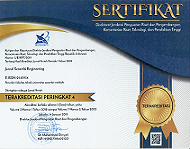Kinerja Papan Komposit Ramah Lingkungan Terhadap Api: Studi Literatur
Keywords:
Papan Komposit, Serat Alami, Ketahanan Api, LOI, Ramah LingkunganAbstract
Natural fiber-based composite boards have gained increasing attention as a sustainable and eco-friendly alternative to conventional construction materials. While these materials offer notable mechanical performance and material efficiency, one of the primary challenges lies in improving their resistance to fire. This review presents a comprehensive analysis of existing literature on the fire performance of natural fiber composites, focusing on the role of fiber type, resin formulation, flame retardant additives, and production techniques. Based on a synthesis of ten experimental studies, it was found that composites combining kenaf fibers with phenolic resin and ammonium polyphosphate (APP) demonstrated the highest fire resistance—indicated by a Limiting Oxygen Index (LOI) exceeding 30%, longer ignition times, and slower burn rates. Additionally, fabrication methods such as hot pressing and surface coating proved effective in enhancing thermal resistance. Despite their promise, the adoption of these composites in broader industrial applications is hindered by challenges including energy efficiency, additive costs, and long-term stability. This review suggests that future development should integrate innovative material science with sustainable manufacturing strategies to produce fire-safe, cost-effective, and environmentally responsible composite panels.
References
[1] C. D. C. Dolotina and L. M. T Bo-ot, "Effect of Borax and Boric Acid on Thermal and Flammability Properties of Rice Husk Reinforced Recycled HDPE Composite," Athens Journal of Τechnology & Engineering, vol. 9, no. 1, pp. 43-60, 2022.
[2] P. C. Gómez, T. Pelzmann, . D. R. Hall, C. Chilian and L. L. Lebel, "Carbon fiber damage evolution under flame attack and the role of impurities," FAM Fire and Materials an International Journal, vol. 47, no. 2, pp. 226-240, 2023.
[3] X. Song, F. Song, X. M. Ding, J. M. Wu, X. H. Wang, F. Wang, R. Feng, X. L. Wang and Y. Z. Wang, "Construction of bio-based ramie fabric/epoxy resin composites with high flame retardant and mechanical performances," Industrial Crops and Products, vol. 194, no. 1, pp. 116-281, 2023.
[4] W. Guo, E. Naderikalali, X. Wang, W. Xing, P. Zhang, L. Song and Y. Hu, "Processing bulk natural bamboo into a strong and flame-retardant composite material," Industrial Crops and Products, vol. 138, no. 1, pp. 111-478, 2019.
[5] Y. Y. Wang, Y. Q. Li, W. B. Zhu and S. Y. Fu, "Strong and fire-resistant bamboo enabled by densification and boron nitride/graphene oxide nanocoating," Industrial Crops and Products, vol. 212, no. 1, pp. 118-292, 2024.
[6] Z. H. Han, X. J. Li, B. Tang, Q. W. Tan, Y. Z. Wang and F. Song, "Thermally insulating, water-resistant, and fire-safety fully bio-based wheat straw composites," Polymer, vol. 325, no. 1, pp. 128-287, 2025.
[7] R. O. García, M. Monzon, Z. Ortega and E. Cunningham, "Study and fire test of banana fibre reinforced composites with flame retardance properties," Open Chemistry, vol. 18, no. 1, pp. 275-286, 2020.
[8] V. S. Hiremath, D. M. Reddy, R. R. Mutra, A. Sanjeev, T. Dhilipkumar and N. J, "Thermal degradation and fire retardant behaviour of natural fibre reinforced polymeric composites- A comprehensive review," Journal of Materials Research and Technology, vol. 30, no. 1, pp. 4053-4063, 2024.
[9] M. Sain, S. H. Park, S. Panthapulakkal and S. Law, "Flame retardant and mechanical properties of nature fiber-PP composites containing magnesium hydroxide," Polymer Degradation and Stability, vol. 83, no. 2, pp. 363-367, 2004.
[10] J. S. Renner, R. A. Mensah, L. Jiang and Q. Xu, "Fire Behavior of Wood-Based Composite Materials," Polymers, vol. 13, no. 24, pp. 43-52, 2021.
[11] C. Won, J. W. Kim, D. W. Lee, B. S. Kim and J.-I. Song, "Impact and Fire Retardant Properties of Flax Fiber Reinforced Nanoclay Composites by Taguchi Method," Composites Research, vol. 26, no. 3, pp. 189-194, 2013.
[12] N. M. Nurazzi, M. M. Asyraf, A. Khalina, N. Abdullah, H. A. Aisyah, S. A. rafiqah, F. A. Sabaruddin, S. H. Kamarudin, M. F. Norrahim, R. A. Ilyas and S. M. Sapuan, "A Review on Natural Fiber Reinforced Polymer Composite for Bullet Proof and Ballistic Applications," Polymers, vol. 13, no. 646, pp. 1-42, 2021.
[13] D. R. Putra, H. Sosiati and C. Budiyantoro, "Karakterisasi Sifat – Sifat Tarik Komposit Laminat Hibrida Kenaf/E-Glass Yang Difabrikasi Dengan Matriks Polypropylene," Jurnal Material dan Proses Manufaktur, vol. 1, no. 1, pp. 41-45, 2017.
[14] X. Lu, A. F. Lee and X. Gu, "Improving the flame retardancy of sustainable lignin-based epoxy resins using phosphorus/nitrogen treated cobalt metal-organic frameworks," Materials Today Chemistry, vol. 26, no. 1, pp. 101-184, 2022.
[15] M. H. Guo, Y. Wang and J. L. Fu, "Flame retardancy of lignin-based environment-friendly fiberboard," Journal of Building Materials, vol. 14, no. 5, pp. 649-652, 2011.
[16] A. Arya, A. Ahamad, P. Kumar and A. Chandra, "A review on lignin based nanocomposites: Fabrication, characterization and application," Materials Today Proceedings, vol. 7, no. 8, pp. 1-8, 2023.
[17] C. Elanchezhian, B. V. Ramnath, G. Ramakrishnan, M. Rajendrakumar, V. Naveenkumar and M. K. Saravanakumar, "Review on mechanical properties of natural fiber composites.," Materials Today: Proceedings, vol. 5, no. 1, pp. 1785-1790, 2018.
[18] M. Y. Khalid, A. A. Rashid, Z. U. Arif, W. Ahmed, H. Arshad and A. A. Zaidi, "Natural fiber reinforced composites: Sustainable materials for emerging applications," Results in Engineering, vol. 11, no. 1, pp. 1-7, 2021.
[19] G. C. Ding, "3 - Life cycle assessment (LCA) of sustainable building materials: an overview," Eco-efficient Construction and Building Materials, vol. 1, no. 1, pp. 38-62, 2014.
[20] E. M. Ezeh, "Comparative analysis of natural and synthetic fire retardant additives in Banana Peduncle fibre reinforced Polyester Composites," Moroccan Journal of Chemistry, vol. 9, no. 3, pp. 530-541, 2021.
[21] International Organization for Standardization. Greenhouse Gases: Carbon Footprint of Products: Requirements and Guidelines for Quantification. International Organization for Standardization, 2018.
Downloads
Published
Issue
Section
License
Copyright (c) 2025 Rizky Dwiandra Putra, Dangan Waluyo, Timbul Siahaan, Nurul Ilmi, Alvin Muhammad Savero (Author)

This work is licensed under a Creative Commons Attribution 4.0 International License.












